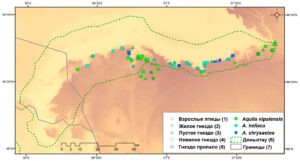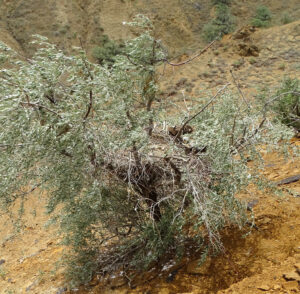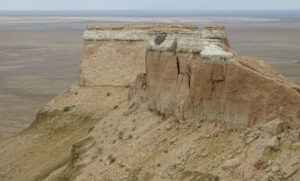Third International Scientific and Practical Conference “Eagles of the Palearctic: Study and Conservation”
Raptors Conservation. Suppl. 2. Proceedings of Conferences
Eagle Nesting Groups in the Important Bird Area “Donyz-Tau cliff faces” in 2022
Smelansky I.E. (The Association for the Conservation of Biodiversity of Kazakhstan, Astana, Kazakhstan; Sibecocenter LLC, Novosibirsk, Russia)
Tomilenko A.A., Barashkova A.N. (Sibecocenter LLC, Novosibirsk, Russia) Aleksandrovich R.N. (The Association for the Conservation of Biodiversity of Kazakhstan, Astana, Kazakhstan)
Aleksandrovich R.N. (The Association for the Conservation of Biodiversity of Kazakhstan,
Astana, Kazakhstan)
Contact:
Ilya Smelansky ilya.smelansky@acbk.kz
Andrey Tomilenko aatom@ngs.ru
Anna Barashkova yazula.manul@gmail.com
Roman Alexandrovich roman.alexandrovich@acbk.kz
Recommended citation: Smelansky I.E., Tomilenko A.A., Barashkova A.N., Aleksandrovich R.N. Eagle Nesting Groups in the Important Bird Area “Donyz-Tau cliff faces” in 2022. – Raptors Conservation. 2023. S2: 142–152. DOI: 10.19074/1814-8654-2023-2-142-152 URL: http://rrrcn.ru/en/archives/34925
The Important Bird Area (IBA) “Donyz-Tau cliff faces” (KZ019), with an area of 387,110 hectares, has been allocated by I.V. Karyakin (2008) based on survey results in 2003–2006. Survey showed several globally threatened and biome-specific species nesting here, including Steppe Eagle (Aquila nipalensis) and Eastern Imperial Eagle (Aquila heliaca), 26 breeding pairs of each species (Karyakin, 2008). Condition of large raptor nesting groups in the IBA was then checked (territories were always checked partially) in 2012, 2017, and 2018.
IBA “Donyz-Tau cliff faces” is located in the Aktobe, Atyrau, and Mangistau regions of Kazakhstan, with 70% of an area belonging to Aktobe region. “Donyz-Tau cliff faces” is part of escarpments that form the northern border of the Ustyurt mesa plateau. In Aktobe region IBA is extended along the “Donyz-Tau cliff faces” in the latitudinal direction. It includes cliff faces itself with a variety of characteristic relief forms, along with adjacent strips of a watershed mesa plateau and a salt marsh depression along the cliff faces foot. Cliff faces scrap within the IBA ranges in width from 5 to 10 km (about 1100 km2), plateau and depression strips do not exceed 10 km as well. Pelitophytic and hemipsammophytic deserts lead among vegetation at plateau, characteristic petrophytic and gypsophytic desert communities predominate here along with steppe and shrub communities in logs and other shady habitats; in the sub cliff faces depression, halophytic succulent and annual saltwort deserts predominate.
IBA survey within the Aktobe region was carried mainly between June 15 and June 25, 2022. Survey route ran along the cliff faces from east to west, from the Aschebulak rise to the border of the Atyrau region (east of the Tamdy massif). Within the IBA, the automobile route was 250 km (+30 km outside of IBA), the length of the inspected cliff faces strip was 150 km, survey went for 10 days (11 overnight stays). Additionally, we used data on bird sightings obtained by a camera trap in August 2022.
For Golden Eagle (Aquila chrysaetos) and Eastern Imperial Eagle, nesting density was assessed not by area, but by the linear extent of favorable nesting biotopes: cliff faces and slopes of erosional ridges, as in previous surveys in the region (Karyakin et al., 2005a; 2005b; 2008; 2009; 2010; 2011). Steppe Eagle nesting density was estimated for the inspected area, which was calculated based on the entire survey route and the effective width of the registration strip, amounting to about 1100 km2.
Steppe Eagle (Aquila nipalensis)
A total of 34 Steppe Eagle nests were found, of which only one was active (occupied). Nine permanent perches were noted. Adult birds were encountered six times (six individuals), including one on the only occupied breeding territory (Fig. 1). Traces of recent (this year) Steppe Eagle visits were noted on seven nests and seven perches. Based on these findings, considering nests locations on the ground, 13 Steppe Eagle breeding territories were found in the examined area, 11 of which had birds or traces of their recent presence (occupied breeding territories), and only one territory had successful breeding. Two breeding territories (five nests) were located outside of IBA, although close to its border.
The average frequency of adult Steppe Eagle encounters was around 2.1 birds per 100 km of the route, encounter density in the study area was about 0.5 birds per 100 km2. Nesting density was 1.2 breeding territories per 100 km2, including 0.09 successful territories per 100 km2.
Three previously known Steppe Eagle breeding territories were inspected. Two of them were first identified in 2012 and then checked in 2017 and 2018. One was first identified in 2017 and has not been inspected until now. All territories were first identified by an occupied nest. No breeding was detected in all three territories so far, two were occupied (traces of recent bird visits were noticed), one was possibly empty.

Fig. 1. Findings of Steppe Eagle (Aquila nipalensis), Eastern Imperial Eagle (Aquila heliaca), and Golden Eagle (Aquila chrysaetos) on the Donyz-Tau cliff faces in the Aktobe region in 2022.
Nests that were found in 2012 have not been preserved, and no new nests were built instead (first disappeared by 2017 already, the second – between June 2018 and June 2022). The nest that was first described in 2017 continues to exist.
The only active nest was located on plateau (about 3.5 km to the edge of the cliff faces slope). When examined on June 15, it contained three nestlings aged from 26–30 to 36–40 days. After 20 days, only one nestling remained in the nest upon the second visit, most likely the eldest (the nest was visited on May 7, 2022, by A.E. Bragin and T. Katzner). Two other nestlings have possibly become prey to Eagle Owl (
Among Steppe Eagle pellets and food remains in nests and near perches, Great Gerbil (Rhombomys opimus) and Yellow Gound Squirrel were repeatedly identified, Steppe Agama (Trapelus sanguinolentus) and unidentified snake were found once. Saiga Antelope (Saiga tatarica) bones were used to build one nest.
Nests inspected in 2022 were built on the ground, on the heap or collapse of stones, on the collapse of stone blocks of armored sandstone slabs on ledges, on burial structures, on low bushes (often leaning on a bush with one side on a slope). All nests were in the open and had enough space around them for grown nestlings to leave. Nests on the metal structures of Trigo points were previously known here, but now they have disappeared, and new ones were not built. Nests are built at relatively gentle cliff faces slopes, low gentle elevations on the plateau (behind the upper tier of the cliff faces), slopes, ridges, and remnant mountaintops of the erosion ridges of the lower cliff faces tier and in subcliff faces depression.
Imperial eagle (Aquila heliaca)
A total of 23 Eastern Imperial Eagle nests were found, nine of which had broods at the time of the survey, in one nest the brood was possibly destroyed by Eagle Owl (traces of a gored nestling were found near an empty nest on a turanga), and a dead clutch was found in another. Thus, inhabited nests accounted for almost half of all examined nests (48%). Eleven adult birds and at least thirteen nestlings were observed in nests (Fig. 1).
The average sightings frequency of adult eagles was 3.9 birds/100 km of route, or 7.3 birds/100 km of route; the sightings density in the examined area (1100 km2) was 0.98 birds / 100 km2. Virtually all observations of adult Eastern Imperial Eagles were in occupied breeding territories. Bird encounter without a connection to an occupied nest was recorded in a single case (nest most likely remained undetected).
Based on the nest findings and bird sightings, 15 breeding territories were localized with certainty, without counting previously disappeared known territories (three of them), including 12 active ones, out of which nine were successful at the time of the check. Nesting density for the entire surveyed area is 1.34 breeding territories/100 km2, including 0.98 active and 0.80 successful breeding territories/ 100 km2. For the length of 150 km of the surveyed cliff faces, nesting density per length of the cliff faces strip was 10 breeding territories/100 km of cliff faces, including eight active territories and of them six successful at the time of the survey / 100 km.
Eight previously known Eastern Imperial Eagle breeding territories (first identified in 2017 and earlier) were surveyed. Two of them turned out to be occupied with successful breeding, one is visited by birds, but no active nests were located. There is still a nest in one territory, but the area is most likely empty. In other four areas, nests have not survived (in two cases nesting trees disappeared as well), and no traces of bird presence were found.
In all cases (n=6), when it was possible to examine nest contents in detail, there were two nestlings in the brood. In other cases (n=4), the number of nestlings in the brood remained unspecified (no less than one nestling). Nestlings age varied from 36 (possibly from 31) to 50 days.
All found nests were located on low trees or large turanga bushes, willow, saxaul, or tamarisk. Usually, the nests were located in the upper fork of the branches or on the largest branch in the tree crown, with an open approach from above and from either side. However, from other sides the nest is often hidden by the tree crown. Nests were located at the bottom of large valleys on cliff faces or on slopes and bottoms of side logs cut into the sides of such valleys, often at the very top of the log, near the foot of the slope.
Golden Eagle (Aquila chrysaetos)
Five adult Golden Eagles were encountered in the surveyed area (including two pairs) and five breeding areas were localized (Fig. 1). Three of these territories were discovered for the first time – all of them occupied by birds, and an active nest found in one. It is possible that the remaining two occupied territories contained successful nests that remained undetected. Two breeding territories that were known since 2017 were checked as well. This year they were not occupied and, judging by nests condition and the absence of visiting signs, they have probably been empty for several years.
The only found inhabited nest contained one fully feathered nestling. Other nestlings from this brood probably left the nest already, but it is more likely that at the time of examination the brood consisted of one nestling (Golden Eagle fledglings in Northern Ustyurt stay close to the nest for the first days after departure, but we did not meet any fledglings despite spending a long time at the breeding territory).
The nesting density per 100 km of cliff faces was 3.3 breeding territories, including two occupied territories and between 0.7 and 2 territories with successful breeding.
In total, 6–8 Golden Eagle nests were identified (some of them were attributed with uncertainty), of which one if residential, the rest are empty. All nests were located on ledges covered with canopies or in niches of high steep slopes of large valleys on cliff faces, on the cliffs of remnant erosion ridges or turtkuls. Typical nest location – at the top part of the slope, on the shelf ledge formed by a cut of the armor plate of the mesa plateau.
The status of nesting groups of eagles
In 2022, the share of active nests and breeding success of Steppe Eagle in IBA are the lowest for the entire observation period. The state of the nesting group can be confidently characterized as unfavorable. It has worsened significantly when compared to the situation in 2017–2018.
In contrast, the state of Eastern Imperial Eagle nesting group is quite good and has undoubtedly not deteriorated in comparison with observations in 2017–2018.
Golden Eagle nesting group appears to be prosperous, but its condition is worse than in 2017 and 2018, when occupied nests with successful breeding were found in all identified breeding territories.
In addition to true eagles, Short-Tailed Eagle (Circaetus gallicus, possibly one occupied breeding territory with an active nest), Cinereous Vulture (Aegypius monachus, encounters with adult birds), and Long-Legged Buzzard (Buteo rufinus) were noted. The latter species is the most numerous: a total of 70 nests of Long-Legged Buzzard were found, of which eight or nine were active: nestlings were found in six of them, one was already abandoned, and in one or two there was unsuccessful breeding (dead clutch, shell remains). 15 adult birds and 11 nestlings and fledglings were accounted. Based on these findings, at least 34 Long-Legged Buzzard breeding territories were located, 14 of which were occupied this year (41%), including 7 (20%) where successful breeding took place at the time of survey.
The state of the territory's ecosystems and economic activity
In 2022, geophysical exploration was actively carried out at the IBA in search for hydrocarbons. The production base of the geological party was located right at the eastern border of the IBA. The work benefits Tethys Petroleum Limited (TPL, Tethys Petroleum Ltd), the subsoil user id “Kul-Bas” LLP, a subsidiary of TPL. The western half of the IBA in the Aktobe region (and its entire territory in the Atyrau region) is located in the contract area where exploration and development of the Kosbulak gas field was carried out, territory belongs to KazAzot LLP since March 2016. In 2022 (as well as in 2017–2019), we did not observe any noticeable activity of the company at the IBA.
From the time when IBA was identified and until 2020, there were no places for keeping livestock or long-term human settlements in its Aktobe part (they were located in its territory located in the Atyrau region). But later, in 2019, a wintering area and a zhailau appeared here, where horses and camels graze. The number of these animals are small and do not have a negative impact on the ecosystems in the area. In 2020–2021, a large number of livestock was located in IBA (including sheep) – they were temporarily transferred from the Mangistau region, where severe drought happened at the time. Traces of grazing and livestock camps are visible.
No other agricultural activity was noted. However, the anthropogenic load on ecosystems has increased significantly compared to the situation before 2020, when there was no agricultural activity. Over the medium term, a great danger is posed by the rapid gas fields development, which is accompanied by the development of linear infrastructure (happening outside of IBA at the time), the emergence and expansion of permanent human presence (people and transport) in the territory.
The authors thank the staff of AСBK A.K. Mukhiev and A.M. Berdesheva for assistance in field work.


